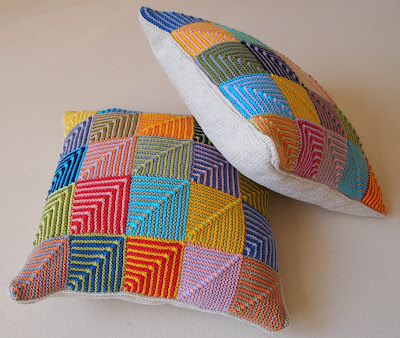Super easy and fun decoration for Easter (which in Bulgaria this year, being Orthodox Christians, we'll celebrate not tomorrow, but on May 5th. I think having
different dates for Western and Eastern Easter is silly, but I suppose some more centuries will have to pass for the clergy to figure out the issue).
I've used again the same scrap yarns and cushion filling as for the mitered square cushions.
Yarn: YarnArt Jeans, 50 % cotton, 50% acrylic, hook 2.5 mm (C).
After a dozen of tries I found that I like my Easter Egg best as follows:
A recipe for an Easter Egg:
1 rnd: Make a magic loop, 6 sc in loop, sl st, pull the thread to close the loop = 6 sc
2 rnd: 1 ch, 2 sc in each sc, sl st = 12 sc
3 rnd: 1 ch, (1 sc in first sc, 2 sc in next), repeat to end of rnd, sl st = 18 sc
4 rnd: 1 ch, 1 sc in each sc = 18 sc
5 rnd: 1 ch, (1 sc in first two sc, 2 sc in next), repeat to end of rnd, sl st = 24 sc
6 rnd: 1 ch, 1 sc in each sc = 24 sc
7 rnd: 1 ch, 1 sc in each sc = 24 sc
6 rnd: 1 ch, (1 sc in first three sc, 2 sc in next), repeat to end of rnd, sl st = 30 sc
8 rnd: 1 ch, 1 sc in each sc = 30 sc
9 rnd: 1 ch, 1 sc in each sc = 30 sc
10 rnd: 1 ch, 1 sc in each sc = 30 sc
11 rnd: 1 ch, 1 sc in each sc = 30 sc
12 rnd: 1 ch, (1 sc in first three sc, 2 sc tog), repeat to end of rnd, sl st = 24 sc
13 rnd: 1 ch, 1 sc in each sc = 24 sc
14 rnd: 1 ch, (1 sc in first two sc, 2 sc tog), repeat to end of rnd, sl st = 18 sc
15 rnd: 1 ch, 1 sc in each sc = 18 sc
16 rnd: 1 ch, (1 sc in first sc, 2 sc tog), repeat to end of rnd, sl st = 12 sc
Fill the egg with suitable toy filling.
17 rnd: 1 ch, (2 sc tog), repeat to end of rnd, sl st = 6 sc
Pass thread through the 6 sc and close slightly the gap, weave in ends.



















































